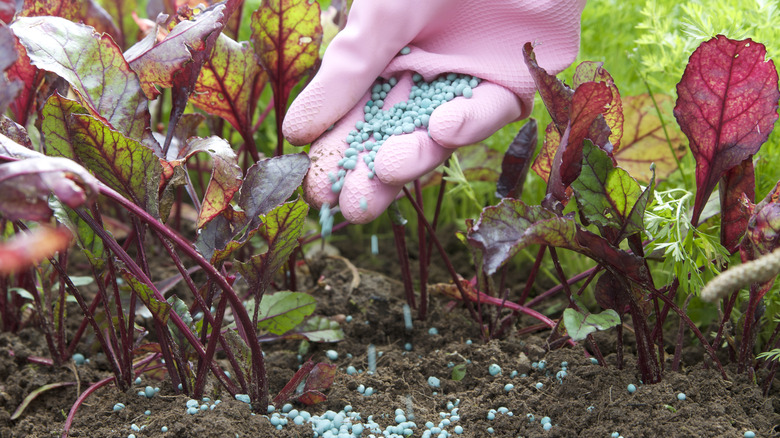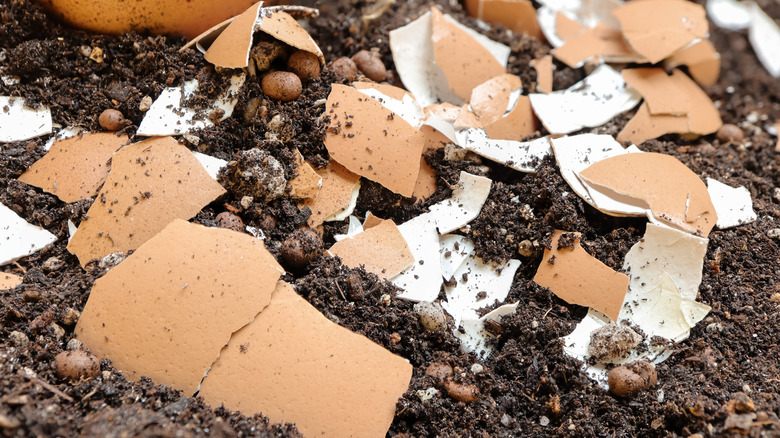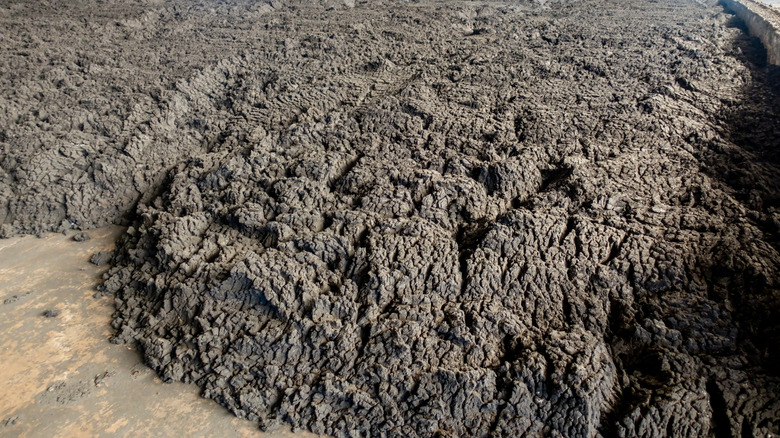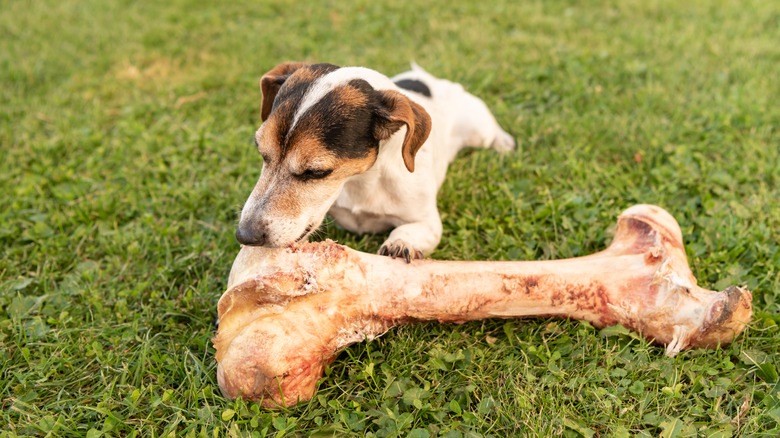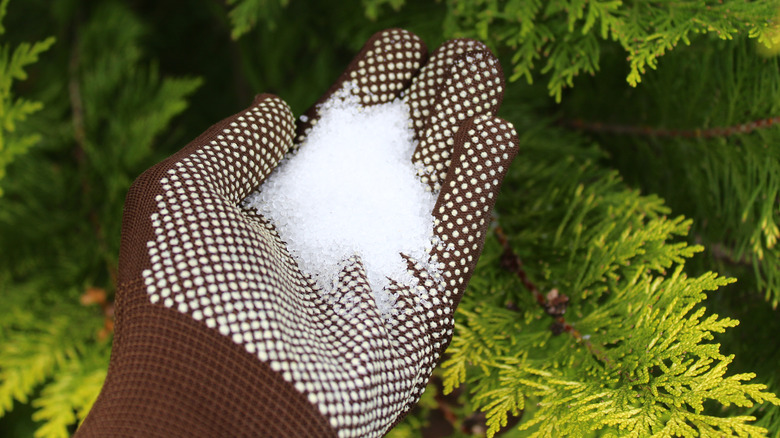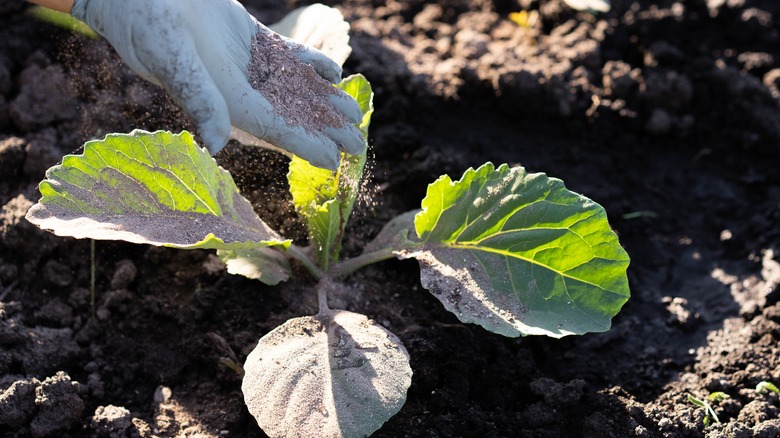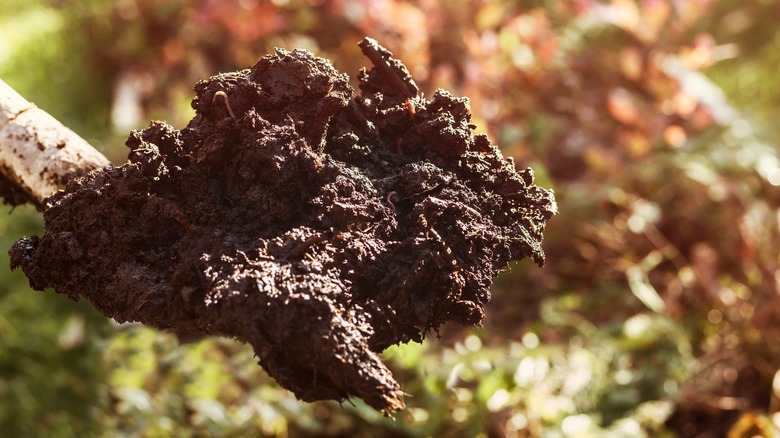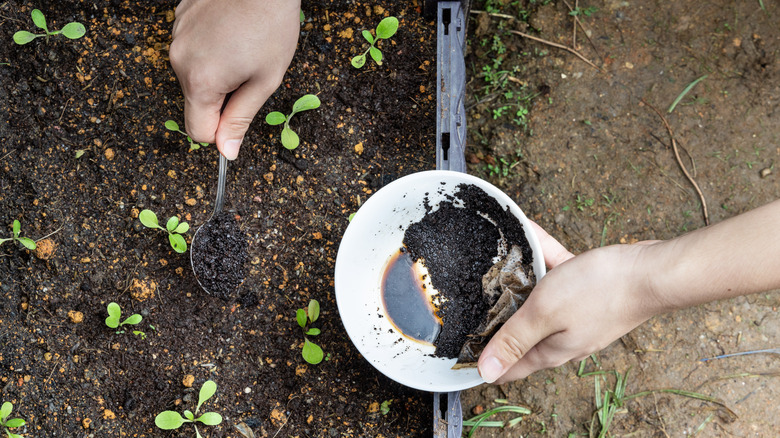Think Twice Before Using Any Of These Things As Fertilizer
Earning the privilege of admiring a glorious, lush garden requires immense labor and love. You must nail down the right planting site, hit the mark on watering, and be spot-on about fertilization. But sometimes, we can become overzealous in our quest for bountiful harvests, verdant foliage, and gorgeous blooms, ultimately doing our plants more harm than good. For instance, a 2020 study by Oregon State University found that several urban gardens have become over-enriched over time. Instead of maintaining their soils' organic content at 3% to 5%, home gardeners overload it with fertilizer and compost, causing the organic concentration to exceed 13%. As it turns out, soils can't hold onto these excess nutrients, forcing them out with rain or irrigation. Unfortunately, such runoff becomes the aquatic ecosystem's bane of existence.
But even if the nutrients weren't an environmental hazard, they can still be detrimental to plants' health. For instance, encouraging your vegetation to feast on fertilizers whose elements aren't missing from the substrate—as is usually the case for Epsom salts, eggshells, and bone meals—is akin to courting disaster. This is because they might impede the plants from accessing other gainful micronutrients. Similarly, fertilizers like biosolids and fresh manure can become gateways for diseases if applied inappropriately. Plus, some fertilizers may remain unavailable if the soil's pH isn't right. So, before fertilizing your plants, get a soil test, and practice caution before using the following fertilizers.
Eggshells must decompose to add nutrient value
If you have an acute fondness for eggs, chances are you've got quite a load of shells to bury in your soil. While there are perks to it—haven't we all, at some point, layered our soils with eggshells for a calcium boost to save our rotting peppers and tomatoes?— it's not all white and yellow. For starters, your soil might not even be deficient, as most home soils have adequate calcium. But even if the case were to the contrary, your plants are unlikely to benefit much, and that's not because eggshells are lacking; they're not. They're chock full of calcium (considering the shells are made of calcium carbonate), sulfur, sodium, potassium, and magnesium. They even enrich soils by releasing organic content, a property missing from most other natural fertilizers. But to do that, they must decompose.
Unfortunately, eggshells take a year or more to break down when tossed in their coarse, cracked hull form—a fact Charles C. Mitchell, an Auburn University-based soil agronomist, found in his 2005 study. One way to release their goodness is to grind the eggshells into a powder and then apply it around your plants. Another option is to boil and soak them overnight and pour the calcium solution after straining. Otherwise, keep your fingers crossed for the shells to crumble in time for the next growth season. However, spare your acid-loving plants the concoction, as eggshells raise the soil's pH.
Biosolids might leak metals and pathogens
Biosolids, or sewage sludge, are biologically treated, processed forms of wastewater. Given their high organic matter and nutrient content (rivaling manure), they're popularly used to fertilize unproductive crop soils. In fact, the EPA estimates almost 906,000 tons of biosolids are used in home gardens and landscapes—partly attributable to cities giving away the sludges as compost or semi-solids to their citizens. However, you might want to think twice before using these recycled splendors in your garden. In addition to their funky odors, wastewater processing leaves the sludges mired in harmful pathogens and heavy metals (think lead, mercury, and the like) that plants can take in. For instance, shrubs growing in acidic soils (under pH levels of 6.8) are at a high risk of absorbing cadmium and lead.
While raising phosphorus and organic content levels can stave off the issue to an extent, it can't eliminate it. That's why the NYS Department of Environmental Conservation (DEC) has banned the use of biosolids in vegetable home gardens, although they're allowed for ornamental plantings. Remember, curious toddlers might be at risk of suffering metal contamination if they unwittingly snack on the sludge-enriched soil. So, top-dress biosolids with mulch or topsoil to sidestep such concerns. Also, only use Class A biosolids, as they've been treated rigorously to meet the highest safety standards—Tiktok's favorite lawn fertilizer, Milogranite, is one. Don't forget to check the labels for salt content, as some biosolids contain dangerously high sodium levels.
Bone meal maims beneficial root fungi
Anyone starting an organic garden or fluttering past a home center's organic fertilizer aisle is privy to the virtues of bone meal. Made by cleaning, steaming, and grinding animal bones into a fine powder, bone meal is a massive source of phosphorus that stimulates root growth. It's so prevalent that some gardeners dither when planting their tubers without it. But, most home soils aren't deficient in phosphorus unless they're highly acidic or sandy. So, serving your plants bone meal without a soil test is a bad call.
Mycorrhizal fungi, the beneficial microbes homing in the roots of over 80% of plant species (per OSU extension), can't perform their nutrient-sharing job when the soils are high in phosphorus. This causes the roots to redirect the resources from other plant parts to themselves to extend their spread. So, the roots grow, but at the cost of the plant's health. This problem is especially grave in seedlings and new transplants and can't be improved by applying mycorrhizal spores.
Moreover, the bonemeal can attract pests like raccoons and skunks. Pets may also be attracted to it, and it's toxic if ingested (per Pet Poison). Plus, bone meal's phosphorus content isn't bio-available in soils with a pH exceeding 7 (via CSU extension). Excess phosphorus can run down post-rain, triggering eutrophication (algal bloom formation) in water sources, depriving aquatic life of oxygen and killing them prematurely.
Epsom salts impair the plant's ability to absorb micronutrients
Epsom salts have garnered a cult following due to their high magnesium (10%) content that plants desire for photosynthesis. However, your plants must be deficient to begin with. Unlike the marketed jargon, most home soils are rich in magnesium, with sandy and acidic (pH levels under 5.5) soils being exceptions. So, when you fill your nightshade family's planting hole with a scoop of Epsom elixir or spritz it on the first signs of blossom end rot (fruits' bottoms displaying rotting black bruises), you're harming the plants. This is because high magnesium levels interfere with their ability to absorb calcium, the primary nutrient authorized to build cell walls. So, the truth is that Epsom salts don't solve the rotting problem; they aggravate it (via the NDSU extension).
Aside from calcium, boron, potassium, manganese, and iron uptake becomes onerous when soils are fertilized excessively with Epsom salts, according to Dr. Linda Chalker-Scott's 2018 review. A 2020 Sarkar et al. study found that Gerberas flowers became smaller when fed higher doses of magnesium sulfate once the magnesium deficiency was reversed—implying these salts can worsen the situation. Worse, if your soils are prone to leaching, Epsom salts accumulate in the soil or reach the groundwater table, becoming a pollutant. However, in small amounts, Epsom salts can sometimes be effective when growing certain plants, such as cucumbers and lettuce.
Wood ashes reduce acidity to undesirable levels
With fireplaces becoming a ubiquitous décor feature, most households today have ready access to wood ashes. Constituting 20% calcium, 5% potash, and 2% phosphorus, along with traces of magnesium, iron, boron, and such, there's much to love about them. Unfortunately, wood ash might not be good for your garden soil, as it neutralizes its acidity with its high carbonate levels (a post-burning aftereffect). Naturally, acid-loving plants like rhododendrons, red maples, camellias, blueberries, and birch trees don't appreciate the greater alkalinity, growing stunted. To add insult to injury, other plants join their ranks if the pre-existing pH levels are at 6.5, as that's the most conducive condition for nutrient uptake and growth.
Worse, after feeding on wood ash, some plants experience higher vulnerability to syndromes like chlorosis or potato scabs—club root-suffering brassica varieties are an exception. Further, as the ash is highly water-soluble, excessive applications create the risk of surface runoff, turning the soil saline and damaging plants. You can't even afford to leave any ash remnants on the foliage, as it may cause burns. Another con is that the source wood is sometimes contaminated with toxic elements like lead and cadmium, which can flow into plants through the ash fertilizer. To circumvent such outcomes, use naturally sourced firewood and avoid treated lumber at all costs. Base wood ash application on a soil test, and don't forget to wear protective equipment, as exposure causes skin irritation.
Fresh manures invite pathogens
While the question of manures being a fertilizer or not may be moot, their utility to organic gardeners is not since they contain nutrients (NPK and micro) and organic matter. However, using them fresh (without composting) is akin to laying down a red carpet for disease-causing bacteria. With instances of Listeria, E. coli, and Salmonella contaminating edibles and transmitting to people, the USDA National Organic Program has stipulated that fresh manures shouldn't be applied if the countdown to harvest is short of 120 days. But if the vegetable's edible part doesn't contact the soil (think corn, tomatoes, peppers), the cutoff changes to 90 days.
Besides, as fresh manures are rich in soluble nitrogen, they must be mixed into the soils within 12 hours of availability. Otherwise, the nitrogen evaporates, diminishing their utility. They also aren't very effective if you use copious quantities of sawdust or straw around your plants, as the high carbon content binds the nitrogen. Another pitfall is that fresh manures, especially poultry-sourced, are highly saline, risking salt injury in plants. However, the risk can be minimized by sowing seeds after 3 to 4 weeks of manure application. Some horse-based manures may enclose viable weed seeds (owing to their poor digestion), boding ill for your yard. To avoid problems, use composted manure or delay the application to fall for spring-growing crops. Don't forget to spread mulched leaves over the manure to keep it intact after rain. Also, skip pig, cat, and dog litter.
Coffee grounds are nutrient-poor
Coffee may get you through the day, but it doesn't do much for your plants, at least not from a fertilization POV. Sure, the grounds have some nitrogen, the classic macronutrient most plants can never get enough of. But the concentration sits at about 1 to 2%, which soil microbes consume as their fee for breaking down the coffee grounds! While this improves the soil's texture and permeability, the nutritional profile remains relatively untouched. As a result, you're forced to add supplementary nitrogen sources into the soil in the form of grass clippings or alfalfa meal.
Similarly, while coffee grounds contain "plenty" of micronutrients, including calcium, potassium, magnesium, iron, phosphorus, and zinc, their concentration is anything but plenty, meaning they'll leave your plants begging for more. To boot, if you work un-composted coffee grounds into the soil, they might even worsen matters by repressing germination or maturation in some plants—geraniums, alfalfa, and asparagus ferns, to name a few. Likewise, using coffee grounds to fertilize orchids often fails because they don't blend well with the orchid mix, restricting air and water movement and ultimately causing root rot. But if you insist on using them—recycling is better than trashing after all—either add them to your compost pile (limit to 10% to 20% volume) or spread them ½ inch thick on the ground and cover with a 4-inch-thick layer of wood chips, bark, or leaves to prevent caking.
